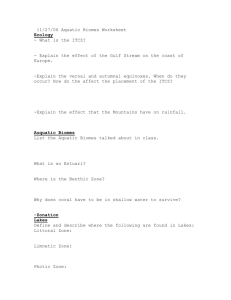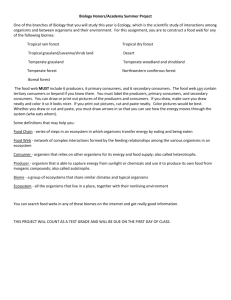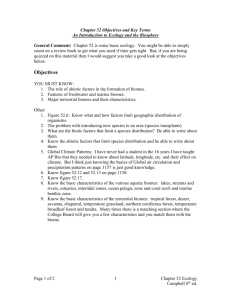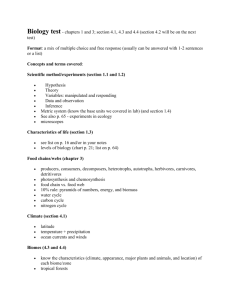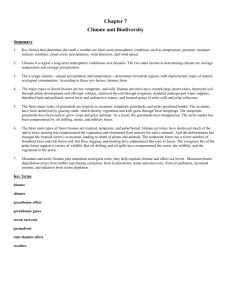An Introduction to Ecology & the Biosphere
advertisement
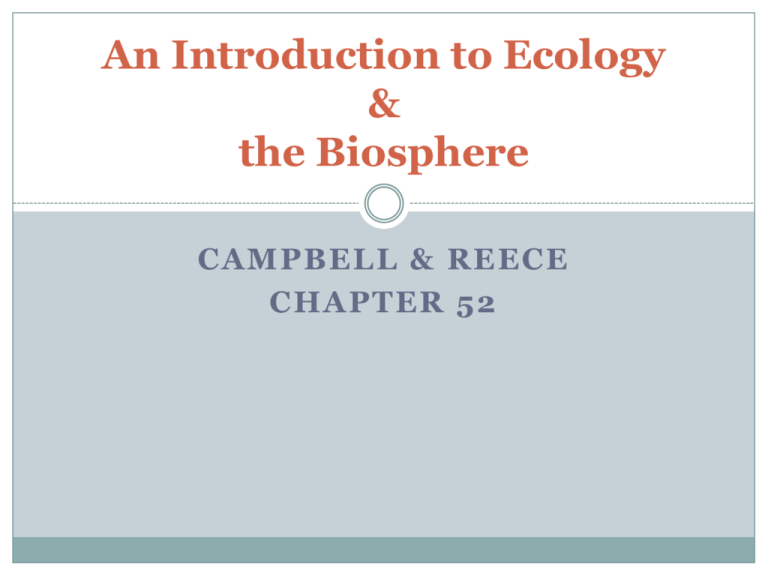
An Introduction to Ecology & the Biosphere CAMPBELL & REECE CHAPTER 52 Ecology from Greek, oikos = home scientific study of interactions between organisms & environment Scope of Ecological Research Organismal Ecology: concerned with individual’s structure, physiology, behavior & its challenges posed by its environment Population Ecology:analyzes factors that affect population size; how & why it changes over time Community Ecology: interactions between species: how predation, competition affect community structure Ecosystem Ecology: nrg flow & biochemical cycling between organisms & their environment; abiotic factors included Landscape Ecology: factors controlling exchanges of nrg, materials & organisms across multiple rcosystems Global Ecology: how regional exchange of nrg & materials influences functioning & distribution of organisms across the biosphere Climate long-term, prevailing weather conditions in given area *most significant influence on the distribution of organisms on land & in oceans 4 Components of Climate Temperature 2. Precipitation 3. Sunlight 4. Wind 1. Global Climate Patterns determined mostly by input of solar nrg 1. establishes temp variations cycles of air & water movement evaporation of water dramatic latitudinal variations in climate 2. Earth’s movement in space Latitudinal Variation in Sunlight Intensity Earth’s curved shape causes latitudinal variation in intensity of sunlight. because sunlight hits Tropics (23.5° N and 23.5° S latitude) most directly, more heat & light /unit surface area are delivered there @ higher latitudes sunlight strikes Earth @ oblique angle so light nrg more diffuse on Earth’s surface Global Air Circulation & Precipitation Patterns intense solar radiation @ equator initiates global pattern of air circulation & precipitation hi temps evaporate water warm, wet air rises flow toward the poles air cools precipitation dry air masses descend @ ~ 30° latitude (N & S) @~60° latitudes air rises cool precipitation to poles Global Air Currents Wind Patterns air flowing close to surface creates predictable global wind patterns as Earth rotates land near equator moves faster than that @ poles, deflecting the winds from staying on vertical path cooling trade winds blow east west in the tropics prevailing westerlies blow from west east in temperate zones Global Wind Patterns Climate Macroclimate: patterns on the global, regional, & landscape level Microclimate: very fine localized patterns Climate patterns can be modified by: seasonal variations in climate large bodies of water mountain ranges Seasonality Earth’s tilted axis of rotation & revolution around Sun every year cause strong seasonal cycles in mid to hi latitudes Bodies of Water because of hi specific heat of water, oceans & large lakes tend to moderate the climate of nearby land hot day: land warmer than water air over land warms & rises draws cooler air from over water to land @ night: land cools faster than water air over now warmer water rises draws cooler air over land back over water Lake-Effect Snow Global Circulation of Surface Water Mountains Microclimate every environment on Earth is characterizes by small-scale differences in abiotic factors chemical & physical attributes: temperature, amt of shade, light, water & nutrients, fallen tree used as shelter Global Climate Change increasing greenhouse gas concentrations in the air are warming Earth & altering the distributions of many species some will thrive others will not be able to shift their ranges quickly enough to reach suitable habitat Biomes major life zones characterized by vegetation type (in terrestrial biomes) or by the physical environment (in aquatic biomes) Climograph plot of annual mean temperature & precipitation in a particular region Climograph for Some Major Biomes Climographs show that temp & precipitation are correlated with biomes because other factors also play a role in biome location: biomes can overlap General Features of Terrestrial Biomes most named for major physical or climatic features & for their predominant vegetation each biome also characterized by: microorganisms fungi animals all adapted to that particular environment Ecotone area of integration: where biomes overlap Terrestrial Biomes layering w/in biome due to shapes & sizes of plants flora dependent on annual precipitation & temps Biome Species Composition varies w/in each biome ex: eastern part of one large lake may have different water bird than western portion Disturbance event that changes a community: removes organisms from it & alters the resource availability ex: forest fire Tropical Forest Distribution: equatorial & subequatorial Precipitation: Tropical Rainforest: constant, 200 -400 cm/yr Tropical Dry Forest: seasonal, 150 – 200 cm/yr Temperature: high all yr, average 25 – 29°C , little seasonal variation Tropical Forest Tropical Forest: Plants vertically layered intense competition for light Tropical Forest Plants Tropical Dry Forest Tropical Rainforest see all layers, some with 2 layers of subcanopy trees broadleaf evergreen trees dominate epiphytes (air plants) & orchids typically cover trees see fewer layers drop leaves during dry season commonly have thorny shrubs & succulent plants Tropical Forest: Animals millions of species 5 – 30 million undiscovered species of insects, spiders, other arthropods highest animal diversity than anywhere else on Earth all adapted to vertically layered environment Tropical Forest: Human Impact thriving communities of man have lived in tropical forests for hundreds of years overpopulation leading to agriculture & development are destroying many tropical forests DESERT Distribution: occur in bands near 30° N & S latitude or in interior of continents Precipitation: low & variable; <30 cm/yr Temperature : variable seasonally & daily hot desert: max T may > 50°C dry desert: low T may < -30°C World Distribution of Deserts Deserts Desert Plants see low, widely scattered vegetation see more bare ground than other terrestrial biomes succulents cacti euphorbs deeply rooted shrubs & herbs grow during brief rainy periods Desert Plants Adaptations: heat & desiccation tolerance water storage reduced leaf surface area CAM photosynthesis physical defenses: spines chemical defenses: toxins in leaves of shrubs Desert Animals Common animals: Snakes Lizards Scorpions Ants Beetles Birds: migratory & resident seed-eating Rodents Desert Animal Adaptations many species are nocturnal water conserved in variety of ways: only water some get is by metabolizing carbohydrates water + carbon dioxide Desert: Human Impact use of long distance transport of water & deep groundwater wells have allowed large populations of man to make the desert their home end result decreased diversity of some deserts SAVANNA Distribution: equatorial & subequatorial Precipitation: seasonal rainfall 30 – 50 cm/yr dry season can last 8 – 9 months Temperature : warm year-round: 24 – 29 °C more seasonal variation than tropical forests Savanna Distribution Savanna Savanna Plants scattered, variable density of trees most plants have small leaves (adaptation to dry conditions) Fires common in dry season: most dominant plant species are fire-adapted & drought-tolerant grasses & forbes (clover, wildflowers) tolerant of large grazing herbivores Savanna Animals dominant herbivores are insects especially termites large herbivores migrate toward thicker vegetation & watering holes during dry season Savanna: Human Impact earliest humans lived in the savanna agriculture & hunting (poaching) have reduced #s of large mammals Chaparral also called mattoral (Spain & Chile) garigue & maquis (southern France) fynbos (South Africa) Chaparral Distribution: midlatitude coastal regions Precipitation: highly seasonal (rainy winters, dry summers) averages 30 – 50 cm/yr Temperature : fall, winter, spring are cool (10 – 12°C) summer can get > 40°C Chaparral Distribution Chaparral Chaparral Plants dominated by shrubs, small trees, variety of grasses & herbs plant diversity high though some species found only in very limited areas adaptations to: drought: tough evergreen leaves fire: herb seeds only germinate after hot fire roots are fire resistant (plants re-sprout quickly) Chaparral Animals natives include: browsers (deer, goats) high diversity of small mammals many amphibians, birds, reptiles, insects Chaparral: Human Impact due to increased agricultural use of land chaparral areas have been heavily settled & reduced man contributes to fires Temperate Grassland also called: veldts (South Africa) puszta (Hungary) pampas (Argentina & Uruguay) steppes (Russia) plains & prairies (North America) Temperate Grasslands Temperate Grassland Precipitation: highly seasonal: dry winters/wet summers averages vary between 30 – 100 cm/yr periodic drought is common Temperature : winters cold (< -10°C) summers moderately hot ( 30°C) Temperate Grasslands Temperate Grasslands: Plants dominant plants are grasses & forbs some grasses 2 m high many adapted to survive periodic drought & fires grazing by herbivores helps prevent establishment of woody plants Temperate Grasslands: Animals native mammals large: bison, wild horses small burrowers: prairie dogs Temperate Grasslands: Human Impact most grasslands of North America & Eurasia converted to farmland in other grasslands grazers have turned the grasslands deserts desertification: Patagonia, Argentina Northern Coniferous Forest aka: taiga Distribution: broad band across northern North America & Eurasia to edge of arctic tundra Precipitation: 30 – 70 cm/yr periodic droughts are common Temperature : winters cold (-50°C in Siberia) summers usually >20°C Northern Coniferous Forest Northern Coniferous Forest: Plants dominated by cone-bearing trees pine, spruce, fir, hemlock some require fire to regenerate shape of conifers prevents too much snow accumulating…so branches don’t break needle-or scale-like leaves reduce water loss lower diversity of shrubs & herbs than in temperate broadleaf biomes Northern Coniferous Forest: Plants Northern Coniferous Forest: Animals Birds: residents & summer migrants insects occasionally kill large tracts of trees Mammals: Moose Brown Bear Siberian Tiger Northern Coniferous Forest: Human Impact logging increasing at alarming rate not many old stands remain Temperate Broadleaf Forest Distribution mainly in midlatitudes of northern hemisphere smaller areas in Chile, South Africa, Australia, New Zealand Temperate Broadleaf Forest Precipitation: 70 to > 200 cm/yr (includes snow) all seasons have precipitation Temperature : winter averages ~ 0°C summers hot & humid/ up to 35°C Temperate Broadleaf Forest Temperate Broadleaf Forest: Plants mature forest has distinct vertical layers including a closed canopy dominant plants in North America are deciduous trees adaptation: drop leaves as weather gets colder: uptake of water by roots not feasible when soil frozen dominant plant in Australia: Eucalyptus Temperate Broadleaf Forest: Animals mammals, birds, insects make use of vertical layers many mammals hibernate in winter many birds (and some butterflies) migrate south Temperate Broadleaf Forest: Human Impact virtually all original deciduous forests in North America have been destroyed by urban development or logging…but have great capacity for recovery: some areas are returning over much of their original range Tundra Distribution: covers arctic: 20% Earth’s land surface tops of high mountains Precipitation: 20 – 60 cm/yr in arctic tundra >100 cm/yr alpine tundra Temperature: winter averages < -30°C summer averages < 10°C Tundra Tundra Tundra: Plants mostly herbaceous: mosses, grasses, forbs + dwarf shrubs & trees, lichens permafrost (frozen ground year round) prohibits growth of plant roots Tundra: Animals Birds: migratory, arriving for nesting in summer Mammals: Residents: musk ox Migrators: caribou, reindeer Predators: bears, wolves, foxes Tundra: Human Impact sparsely populated but has been greatly impacted by mineral & oil extraction Aquatic Biomes charaterized primarily by their physical environment rather than be climate often layered with regard to light penetration temperature community structure Zonation in Aquatic Biomes light absorbed by water itself + photosynthetic organisms so…light intensity decreases rapidly with depth Photic Zone: sufficient light for photosynthesis Aphotic Zone: little light penetrates Pelagic Zone = photic zone + aphotic zone Zonation in Aquatic Biomes Abyssal Zone: 2,000 – 6,000 m deep Benthic Zone: the bottom of all aquatic biomes, shallow or deep Benthos: communities of organisms that live in sand & sediments of the benthic zone More Definitions Detritus: dead organic material that “rains” down from photic zone; food source for benthos Thermocline: narrow layer of water where there is an abrupt temperature change separates the more uniformly warm upper layer from the uniformly cold deeper water many temperate lakes undergo a semiannual mixing of their water Lakes lake environment generally classified on basis of 3 physical criteria: 1. light penetration photic / aphotic 2. distance from shore / depth of water littoral / limnetic 3. open water / bottom pelagic / benthic Marine Zonation classified by 3 criteria: light penetration 1. photic / aphotic 2. distance from shore / depth of water intertidal / neritic / oceanic 3. open water / bottom pelagic / benthic / abyssal Lakes standing bodies of water range from ponds a few square meters in area to lakes covering thousands of square kilometers Lake: Chemical Environment lakes differ greatly in their salinity, O2 concentration, & nutrient content Oligotrophic Lakes: nutrient poor O2 rich low in amt of decomposable matter Eutrophic Lakes: nutrient rich O2 poor in deepest zones in summer high amt decomposable matter Lakes: Geologic Features oligotrophic lakes can become more eutrophic over time as runoff adds sediments & nutrients oligotrophic lakes tend to have less surface area relative to their depth Lakes: Oligotrophic Lakes: Eutrophic Lakes: Photosynthetic Organisms Littoral Zone: shallow, well-lit waters close to shore rooted & floating aquatic plants Limnetic Zone: waters too deep to support rooted plants phytoplankton, including cyanobacteria Phytoplankton Lakes: Heterotrophs Limnetic Zone: small, drifting heterotrophs or zooplankton (graze on phytoplankton) Benthic Zone: assorted invertebrates (species depends on O2 content) Fishes live in all zones that have sufficient O2 Zooplankton Lakes: Human Impact Runoff from fertilized land & dumping wastes water nutrient enrichment algal blooms O2 depletion fish kills Wetlands habitat that is inundated by water (at least part of the year) & supports plants adapted to watersaturated soil due to high organic production by plants & decomposition by microbes: water & soil of wetlands periodically low in dissolved O2 *high filter capacity: both nutrients & pollutants Wetlands: Geologic Features Basin Wetlands: develop in shallow basins range: upland depressions filled in lakes Riverine Wetlands: along shallow & periodically flooded banks of streams Fringe Wetlands: along coasts of large lakes & seas water flows back/forth due to changing water levels or tides fresh water & marine biomes Basin Wetlands Riverine Wetlands Fringe Wetlands Wetlands: Autotrophs among most productive biomes in world water-saturated soils great for plants Lily pads Cattails Sedges Tamaracks Black spruce Wetlands: Heterotrophs diverse community of invertebrates, birds, reptiles, amphibians, and mammals Herbevores: crustaceans aquatic insect larvae muskrats Carnivores: dragonflies frogs alligators herons Wetlands: Human Impact draining & filling have destroyed up to 90% of wetlands Streams: Physical Environment most prominent characteristic: their current stratified into vertical zones Streams: Physical Environment Headwaters: generally cold, clear turbulent, & swift Downstream: generally warmer more turbid Streams: Chemical Environment salt & nutrient concentrations increase as get further from headwaters Headwaters: generally rich in O2 Downstream: + O2 unless has organic enrichment Streams: Geologic Features headwaters: downstream: often narrow with rocky wide stretches bottom alternate between shallow sections & deeper pools meandering silty bottoms Streams: Photosynthetic Organisms rivers that flow thru grasslands or deserts have phytoplankton or rooted aquatic plants Streams: Heterotrophs great diversity of fishes & invertebrates inhabit unpolluted streams distributed in vertical zones organic matter from terrestrial vegetation is primary source of food for aquatic consumers Streams: Human Impact pollutants from municipal, agricultural, & industrial sources kill aquatic organisms damming & flood control impair natural functioning of stream ecosystems & threaten migratory species (salmon) Estuary a transitional area between river & sea when high tide: salt water flows up estuary channel higher density sea water stays below lesser density freshwater Estuary: Chemical Environment salinity varies from that of freshwater sea water & with rise & fall of tides nutrients from rivers make estuaries some of most productive biomes Estuary: Geologic Features complex network of tidal channels, islands, natural levees, & mudflats Estuary: Photosynthetic Organisms saltmarsh grasses & algae (including phytoplankton) are major producers Estuary: Heterotrophs abundant #’s of worms, oysters, crabs, & many fish many invertebrates & fishes use estuaries as breeding grounds crucial feeding grounds for birds & some marine mammals Estuary: Human Impact Filling, dredging, & pollution have disrupted estuaries worldwide Intertidal Zones are periodically submerged & exposed by the tides, 2x daily on most marine shores upper zones exposed to air for longer periods greater variation in temp & salinity changes in physical conditions from upper to lower zones limits the distribution of many organisms to particular strata Intertidal Zones: Chemical Environment O2 & nutrient levels generally high & renewed with each turn of the tides Intertidal Zone: Photosynthetic Organisms high diversity & biomass of attached marine algae inhabit rocky intertidal zones much lower diversity & biomass in sandy intertidal zones with vigorous wave action sandy intertidal zones in protected bays or lagoons have rich beds of grass & algae Intertidal Zone: Heterotrophs animals here have multiple structural adaptations rocky areas: ways to attach to hard surfaces sandy areas: many bury themselves feed on what tides bring them Intertidal Zones: Human Impact oil spill have disrupted ecosystem of many intertidal zones construction of rock walls, barriers to reduce damage from erosion, storm surges also disrupts these zones Ocean Pelagic Zone open blue waters mixed constantly by wind & ocean currents photic zone extends deeper here (water is clearer) Oceanic Pelagic Zone: Chemical Environment O2 levels generally high nutrient levels generally lower than in coastal waters tropical oceans: thermally stratified all year temperate & hi-latitude oceans have spring & fall turnover so generally nutrients renewed in photic zone Oceanic Pelagic Zone: Geologic Features covers ~70% Earth’s surface average depth = 4,000 m deepest point: 10,000 m Pelagic Zone: Photosynthetic Organisms phytoplankton (including photosynthetic bacteria) dominate due to vast area this zone covers: ~50% of all photosynthesis on Earth by them Pelagic Zone: Heterotrophs zooplankton most abundant group in this zone graze on phytoplankton includes: protists worms copepods shrimp-like krill jellies small larvae of invertebrates Pelagic Zone: Heterotrophs also include free-swimming animals: large squid fishes sea turtles marine mammals Pelagic Zone: Human Impact overfishing has depleted fish stocks in all oceans all also polluted Coral Reefs formed largely from the calcium carbonate skeletons of corals in photic zone of relatively stable tropical marine environments with high water clarity sensitive to temps < 18 – 20° & > 30°C found in deep seas 200 -1,500 m deep as much diversity as shallow reef Deep Sea Coral Reef Shallow Coral Reef Coral Reef: Chemical Environment require high O2 levels Coral Reef Geologic Features Corals require a solid substrate for attachment typically: begins as fringing reef on young, high island forming an off-shore barrier reef as island ages coral atoll Barrier Reef Coral Atoll Coral Reefs: Photosynthetic Organisms unicellular algae live w/in tissues of corals in mutualistic relationship: provides corals with organic molecules diverse multicellular red & green algae growing on reef also photosynthesize Coral Reef: Heterotrophs dominant heterotroph: corals are a diverse group of cnidarians also high diversity of fishes & invertebrates overall nearly as diverse as tropical rainforest Coral Reef: Human Impact populations of corals & fishes on decline due to humans collecting corals & overfishing Global warming & pollution coral death Marine Benthic Zone consists of the seafloor under surface waters of the coastal (neritic) zone * the offshore (pelagic) zone Benthic Zone near-coastal areas only part to receive sunlight water temp declines with depth while pressure increases organisms in very deep abyssal zone adapted to cold (~3°C) & high water pressure Benthic Zone: Chemical Environment O2 levels usually high enough to support divers animal life Benthic Zone: Geologic Features most covered by soft sediments also: rocky surfaces, submarine mts, new oceanic crust Benthic Zone: Autotrophs shallow areas: seaweeds & filamentous algae deep-sea hydrothermal vents: on mid-ocean ridges chemo-autotrophic prokaryotes obtain nrg by oxidizing H2 S formed by a reaction between hot water & dissolved sulfate (SO4 ) Benthic Zone: Heterotrophs numerous invertebrates & fishes beyond photic zone most animals rely on organic material raining down from above many around hydrothermal vents Giant tube worms: eat chemo-autotrophic prokaryotes that live as symbionts w/in their bodies Benthic Zone: Human Impact overfishing has decimated some benthic fish populations (cod) dumping of organic wastes has created oxygendeprived benthic areas Distribution of Species are a consequence of both ecological & evolutionary interactions thru time Ecological Time differential survival & reproduction of individuals that lead to evolution Evolutionary Time thru natural selection, organisms adapt to their environments over time frame of many generations Global & Regional Patterns ecologists ask not only where a species lives but also why it lives there to answer these ?s focus on both biotic & abiotic factors that influence distribution & abundance of organisms Flowchart of Factors Limiting Geographic Distribution Dispersal movement of individuals or gametes from their areas of origin or from centers of high population density dispersal of organisms is critical to understanding the role of geographic isolation in evolution Natural Range Expansion long distance dispersal can lead to adaptive radiation: the rapid evolution of ancestral species into new species that fill many ecological niches Species Transplants by observing the results of intentional or accidental transplants of species to areas where it was previously absent, ecologists may determine if dispersal is a key factor limiting distribution of a species species introduced to new geographic locations often disrupt the communities & ecosystems to which they have been introduced & usually spread beyond area of introduction Behavior & Habitat Selection habitat selection one of least understood processes Insect: some females will only lay eggs near plant that species most prefers thus limiting habitat Biotic Factors If behavior does not limit distribution of species then do other species influence it? Often (-) interactions with predators or herbivores restricts ability of a species to survive & reproduce Biotic Factors besides presence or absence of predators or herbivores presence or absence of pollinators, food resources, parasites, pathogens, & competing organisms can act as biotic limitations on distribution of a species Abiotic Factors temperature, climate, water, oxygen, salinity, sunlight, soil can all limit a species distribution most areas have fluctuations in nearly all these abiotic factors some organisms can avoid some of the more extreme annual fluctuations dormancy storage of food or water supplies Temperature important abiotic factor in distribution of organisms because of its effect on biological processes cells would rupture if water in them freezes when 0°C proteins of most organisms would denature if temp > 45°C extraordinary adaptations allow some species to survive in temp ranges other organisms cannot survive in Colors of Pool due to Thermophiles Water & Oxygen terrestrial organisms face nearly a constant threat of dehydration: their distribution reflects their ability to obtain & conserve water water affects oxygen availability in aquatic environments & in flooded soils surface waters of streams tend to be well oxygenated due to rapid exchange with atmosphere Salinity affects water balance of organisms thru osmosis most organisms can excrete excess salts by specialized glands or in feces & urine salt flats or other high-salinity habitats have few species of plants or animals Salmon go from freshwater salt-water & back have both behavioral & physiological mechanisms to osmoregulate they adjust amt water they drink to balance their salt content gills switch from taking up salt in freshwater to excreting salt in sea-water Sunlight in aquatic environments, every meter of water depth absorbs 45% of red light & ~2% of blue light passing thru it Sunlight too much increases temps as in deserts which stresses plants & animals @ high elevations sunlight more likely to damage DNA & proteins because atmosphere is thinner so get more UV radiation this damage + other abiotic factors reason why there is a tree line on mountain slopes Rocks & Soil pH, mineral composition, physical structure of rocks & soil limit distribution of plants & therefore animals that feed on them pH can act directly thru extreme acidic or basic conditions or indirectly by affecting the solubility of nutrients & toxins composition of riverbeds can influence water chemistry influences organisms that can live there

